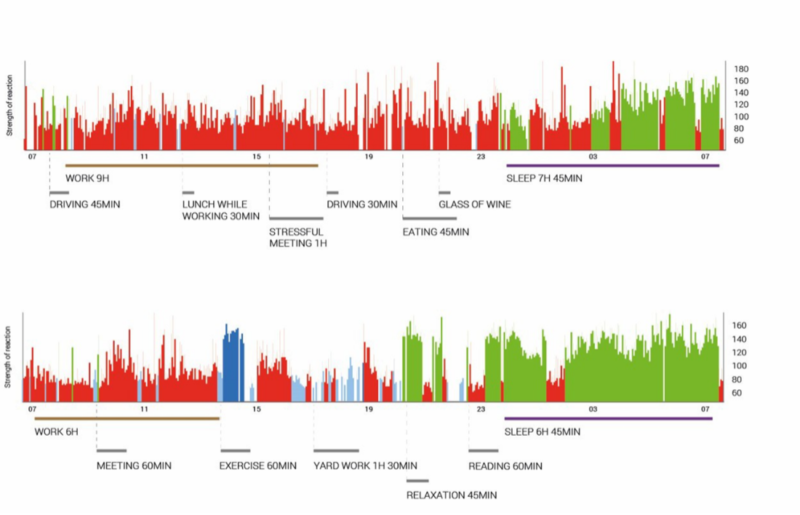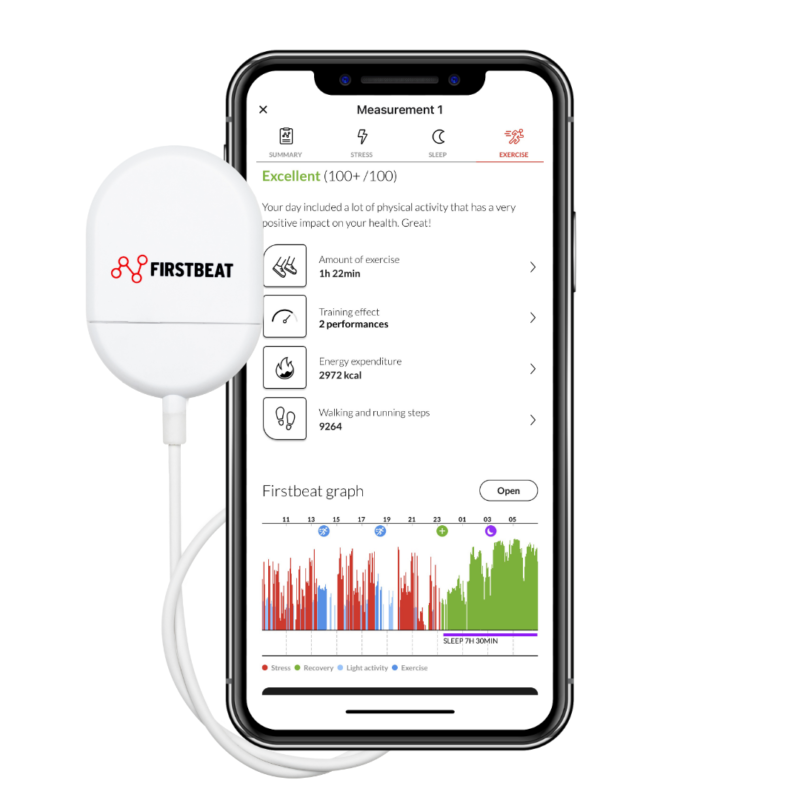
Stress has a negative ring to it but in most cases, it’s not dangerous nor does it need to be eliminated from our lives. It helps us meet life’s challenges. The important thing is making sure stress is not chronic but instead, in proportion with recovery. Numerous studies show that chronic, heavy stress increases the risk for hypertension, heart attack, or stroke and puts you at increased risk for conditions such as anxiety, depression, digestive problems, headaches, and sleep problems.
In this blog, I will discuss stress and recovery from the viewpoint of how you as a coach can upscale your service and make more personalized programs by utilizing physiological data about stress and recovery in your client’s daily life – to gain a deeper understanding of the various drivers and drainers of their well-being. Interviewing the client at the start of a project is a natural first step, but getting objective physiological data to support the subjective view can add powerful value to that discussion – make the often-invisible things visible.
Addressing stress management in coaching discussions is important not only because of the associated health problems, but also from the perspective of good performance. If your client wants to reach their goals (related to general lifestyle, fitness, nutrition, work-life balance, etc.), they need to understand the negative impact that heavy stress can have on overall well-being.
Positive or Negative Stress?
Positive stress usually means tackling a challenge that we enjoy; it could be a new job or relationship, or some other exciting stage of life, whereas negative stress means some kind of overload, pressure, or feeling that there is too much to do. Physiologically, both kinds of stress activate the sympathetic nervous system, to help us perform (illustrated by the red color in the Firstbeat Life graphs below), but in general, positive stress does not prevent recovery afterwards, whereas negative stress tends to keep the body activated even during rest. There are wide individual differences in our ability to handle stress, and no universal guidelines of what an “acceptable” level of positive versus negative stress is. Even positive stress can wear us out, if excessive. When we start looking beyond stress and focusing on recovery instead, we get a better handle on a given individual’s stress tolerance and balance.
Steps to Improve Your Client’s Stress and Recovery Balance
As a coach, you can help your client understand what all impacts their overall load and what role their daily behaviours have on this. This is where the kind of data that Firstbeat Life provides can be very illuminating (see example in Fig. 1). Seeing the client’s activities on different kinds of days and comparing them to the physiological reaction will make it easier for you and your client to identify behaviours that maintain heavy stress levels, versus those that boost recovery, with focus on concrete, realistic actions to improve the balance.
You might benefit from experimenting with and discussing these kinds of topics:
-
- Is the client’s stress level heavy all day, or are there moments of recovery at some point? What did the client do when there was recovery?
- Could the workday be re-structured to allow stress levels to drop and improve focus? Have the client try different work patterns, recovery exercises, or activity breaks.
- What’s the effect of alcohol, caffeine, or a different eating rhythm on stress and recovery during the day and during sleep?
- How is your client sleeping? Discuss the measured result and how they are feeling and experiment with different evening routines. (see our earlier blog for more sleep tips)
Data Adds Value to Different Types of Coaching
Depending on what kind of coaching you do, data can further deepen your approach, in addition to providing a general overview. A fitness coach might want to monitor how the client recovers after different types of workouts (or the timing of workouts) and use this info to finetune the training plan and ensure that heavy workouts (or otherwise stressful periods in the client’s life) are followed by easier exercise. A nutrition coach might be interested in seeing what effect different eating patterns or dietary improvements have on daytime stress levels and the overall balance between stress and recovery. (Read more in this blog). A mindfulness or wellness coach might use data from the client’s daily life to illustrate the benefit of different relaxation activities and help the client build a healthier, more balanced rhythm.

Fig. 1. Example of 2 different days demonstrate the value that data provides for understanding the client’s life more comprehensively (red = stress, green = recovery, blue = exercise). Together with your client, you can start identifying areas that require special focus, versus areas that are looking good.
Learn What Works and What Does Not
Stressful days will happen now and then, and that’s ok, but if we get too accustomed to being constantly stressed out, we no longer see how it affects our wellbeing. After a while, recovery begins to suffer. As coaches, we can help clients understand this and highlight the importance of finding a healthy balance. As with many other aspects of lifestyle and performance, there are no universal solutions for stress management, but with accurate data and sensitive, customized coaching, we can have real impact on our clients’ lives and help them build healthier, more sustainable routines.
Accurate physiological data allows you to understand your clients’ wellness status and identify potential health risks and make better coaching decisions. It helps you to deepen and lengthen your client relationships. Learn more about Firstbeat Life.
If you liked this article, you should subscribe to our newsletter.
You might also be interested in

Why Good-Quality Sleep Should Be at The Heart of All Comprehensive Coaching Programs
Restorative sleep is the basis of good health and performance – it helps the body recover from stress, physical exertion, and fatigue, whereas poor-quality or insufficient sleep predisposes us to…

This Reliable and Easy Way to Test Your Clients’ Fitness Level Is a Must-have for All Fitness Coaches
Whether it’s a new client or one that you have been working with for a while, it’s essential to get a real understanding of their fitness levels – particularly cardiovascular…

New Study Reveals that the Firstbeat Fitness Level Walk is a Valid Tool for Cardiorespiratory Fitness Evaluation in Clinical Populations
Cardiorespiratory fitness (measured as VO2max) is an expression of the body’s ability to deliver and utilize oxygen for energy during physical exercise. It reflects the interplay between respiratory, cardiovascular, and…




